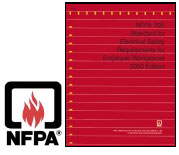
There have been several recent developments in the standards of Electrical Safety. These standards cover virtually every electrical worker in the US and Canada. The goal of these standards is to provide for a safer work environment. Across the industry, arc explosions occur daily (perhaps even as frequent as 1 every 8 hours in the USA alone according to some statistics).
Unfortunately, for every one of these arc explosions, there is a tragic story of disabilities, families broken by divorce and even lives lost. From the perspective of an employer, this is not a hypothetical issue, but one that is likely to severely hit your bank account in the form of medical, rehabilitation and training costs as well as substantial OSHA fines.
There are 7 simple ideas to keep in mind when developing your arc flash protective program.
#1 The Worker: The worker himself is a critical component of a company’s electrical safety program. The electrician himself should be qualified to do the work he/she is being asked to perform. The NFPA 70E requires that the worker possess enough knowledge and training to perform the task (NFPA 70E-2000 2-1.1.2). “A Little Knowledge is a Dangerous Thing”. This could not be more true. If the task is beyond the capabilities of someone, he will be putting his life, the lives of his coworkers around him and a value of a very expensive piece of electrical equipment in jeopardy.
#2 Work Practices: As an employer, you do not want to put your people in harms way. It is desirable to minimize any potential hazard to which your people may be exposed. You must develop a set of work practices, or rules, by which you require your electricians to work. Examples would include:

- Working de-energized
- Use of equipment such as grounding clips and hot sticks
- Lock out – tag out programs, etc
#3 Hazard Assessment: The NFPA 70E-2000 requires every employer of electrical workers to perform a hazard assessment of any task over 50Volts to be performed where there is the potential of an arc flash incident (NFPA 70E-2000 Section 2-1.3.3). The purpose of this assessment is to determine the level of hazard to which the employee will be exposed while performing the task. As a result of this assessment, the employer will be able to provide suitable rated PPE. The hazard assessment begins with the collection of data about the task and the energy available at that site. This would include:
- Bolted Fault Current
- Voltage
- Arc Gap
- Distance from the worker to the Arc Source
- Arc Duration based upon upstream breakers, disconnects etc.
- Arc in a Box (Arc within an enclosed space) With the Voltage known, it is easy to identify
With the Voltage known, it is easy to identify the suitable glove for the work to be performed. The rubber gloves act as an insulation from electric shock (and potential electrocution). They need to have sufficient insulation to resist the conduction of electricity from the source, through your body to ground.
 If you are working on a system with supply voltage of 480 volts (AC), a simple Class “00” glove will be sufficient. However, if you are working on a system with approximately 17kV (AC), you will be looking at a higher Class “2” glove. The higher the glove rating, the greater the insulating capability of the glove. Insufficient or no protection, the energy is likely to pass through your body. Depending upon the amount of current involved, you may receive a small jolt, a substantial burn or even death by electrocution.
If you are working on a system with supply voltage of 480 volts (AC), a simple Class “00” glove will be sufficient. However, if you are working on a system with approximately 17kV (AC), you will be looking at a higher Class “2” glove. The higher the glove rating, the greater the insulating capability of the glove. Insufficient or no protection, the energy is likely to pass through your body. Depending upon the amount of current involved, you may receive a small jolt, a substantial burn or even death by electrocution.Identifying the suitable level of clothing is a little more involved. The gloves you wear are insulation from shock. The clothing you wear is insulation from heat, the thermal energy generated by this terrific explosive release of energy created by the arc. This energy is measured in Calories, or more specifically, calories per square centimeter. To visualize this, consider a cigarette lighter. Your fingertip is approximately 1 square centimeter (cm2). Hold the cigarette lighter about 1 inch under your fingertip. Now light it. You will not be able to hold it there for long. In 1 second, your finger received approximately 1 calorie/cm2. If you cannot hold you finger for such a short duration when exposed to 1 calorie, imagine 8 calories, or 40 calories or even 95 calories. An arc explosion, and its thermal energy should not be taken lightly. Even 2 or 3 calories, a level easily attainable by a 480 volt service, should be treated with respect.
The amount of current available, or the Bolted Fault Current, is a major variable determining the amount of thermal energy produced by the arc explosion. If you are not generating your power on site, contact the engineering department of the local utility (the utility providing the electricity to the site upon which you will be working), and inquire about the current available to the facility. A simple analogy that illustrates this point well is your home … In your basement you may have an electrical panel, which is rated to 100 amps. However, running up and down your street are power lines, which are carrying perhaps 2000 amps of power, to supply not only your house but also the other houses on your street. In the event of an arc incident within your electrical panel, the arc is likely to consume much of the 2000 amps running down your street. It will draw as much power as it can find, releasing it in the form of an arc explosion. The same would occur within your facility. If the local utility is providing the electricity to your facility, potentially all the electricity running down your street could be drawn upon to create the arc. Certainly, equipment, lighting and office equipment would likely lessen the amount of energy available to the arc, yet quantifying the reduction is difficult or impossible. It is often easier to include in your calculations the full Bolted Fault Current, rather than a “guess”. This will at worse overestimate your hazard a bit while increasing your margin of safety.
There are several resources available to you to calculate the level of your potential arc energy exposure. One simple tool is the Duke Power Heat Flux Calculator. This is a simple program that will provide a reasonably accurate calculation. It is a Free Shareware that is available on the Internet (www.arcflash.com/heat-flux-calc.htm). Within NFPA 70E, there are formulas to calculate your hazard levels as well as hazard approach boundaries.
When doing your hazard assessment, it is important to keep in mind the famous computer expression, “Garbage in, garbage out”. It is important to start your calculation with reasonable numbers. If you put into your calculations unreasonably low numbers, the result will be non-representative of the actual hazards and you will be under protecting your people. It is best to start your assessment with reasonable numbers to insure that you have built in a safety factor for your workers.
#4 Protection Greater than the Hazard:
 Using a football analogy, to keep your team in the game, you must have a defense stronger than your competitor’s offense. To protect your employees, you need to insure that the protection they are wearing is stronger (the clothing with a higher calorie rating) than the arc which could potentially be generated by the work they will perform. Just as you would not want to be wearing a bulletproof vest rated for a B-B gun, then get shot by a shotgun. You will likely be dead because despite wearing the vest, it did not afford you enough protection against the shotgun. Nor would it be desirable to be wearing arc flash protection that is under-rated for the thermal hazard. The result of under protection will be severe burns and potentially death.
Using a football analogy, to keep your team in the game, you must have a defense stronger than your competitor’s offense. To protect your employees, you need to insure that the protection they are wearing is stronger (the clothing with a higher calorie rating) than the arc which could potentially be generated by the work they will perform. Just as you would not want to be wearing a bulletproof vest rated for a B-B gun, then get shot by a shotgun. You will likely be dead because despite wearing the vest, it did not afford you enough protection against the shotgun. Nor would it be desirable to be wearing arc flash protection that is under-rated for the thermal hazard. The result of under protection will be severe burns and potentially death. #5 Layering: There has been a lot made of the idea of layering your protection. The goal is to add the protection offered by the various layers of garments (including the protection offered by the airspace between the layers), to create a protective system equal to the hazard. Typically, the FR Cotton or Nomex coveralls used by an employee will provide anywhere from 4 to 11 calories of protection. Add to this a 15 calorie suit and, so the thinking goes, I have around 25 calories of protection. Yes… but no! Yes, the body will have approximately 25 calories of protection by combining the work clothes with the arc suit, but you are not wearing the work clothes on your head. The 15 calorie hood is the only protection for the head, your face is only protected against 15 calories. If the employee is exposed to a 25 calorie arc explosion, his body will be protected, however, his face and head will be severely burned! Modern medicine is wonderful and at times can perform apparent miracles, however, it has its limitation when it comes to repairing ones face after a burn injury.
#5 Layering: There has been a lot made of the idea of layering your protection. The goal is to add the protection offered by the various layers of garments (including the protection offered by the airspace between the layers), to create a protective system equal to the hazard. Typically, the FR Cotton or Nomex coveralls used by an employee will provide anywhere from 4 to 11 calories of protection. Add to this a 15 calorie suit and, so the thinking goes, I have around 25 calories of protection. Yes… but no! Yes, the body will have approximately 25 calories of protection by combining the work clothes with the arc suit, but you are not wearing the work clothes on your head. The 15 calorie hood is the only protection for the head, your face is only protected against 15 calories. If the employee is exposed to a 25 calorie arc explosion, his body will be protected, however, his face and head will be severely burned! Modern medicine is wonderful and at times can perform apparent miracles, however, it has its limitation when it comes to repairing ones face after a burn injury. #6 Surface Area: If it is not covered, it is not protected! Some are tempted to use only a coat or a hood and a coat without pants… unfortunately, not only is this not wise, it is also not in compliance with NFPA 70E. A hazard above 8 calories requires the use of hood, and clothing which covers the entire body. Below this level (Hazard Category 1 and 2), typical FR work clothes and an arc rated faceshield will likely be sufficient for the standard. But regarding faceshields, faceshields are just that, a shield for your face. It is not a head protective devise. It only protects your face (measured by the sensors on the test mannequin at the two eyes, the mouth and under the chin). You may wish to seriously consider the use of a balaclava sock hood when using a faceshield, at these levels below 8 calories, to provide protection to the remaining of your head. However, above 8 calories, NFPA 70E calls for hoods.
#6 Surface Area: If it is not covered, it is not protected! Some are tempted to use only a coat or a hood and a coat without pants… unfortunately, not only is this not wise, it is also not in compliance with NFPA 70E. A hazard above 8 calories requires the use of hood, and clothing which covers the entire body. Below this level (Hazard Category 1 and 2), typical FR work clothes and an arc rated faceshield will likely be sufficient for the standard. But regarding faceshields, faceshields are just that, a shield for your face. It is not a head protective devise. It only protects your face (measured by the sensors on the test mannequin at the two eyes, the mouth and under the chin). You may wish to seriously consider the use of a balaclava sock hood when using a faceshield, at these levels below 8 calories, to provide protection to the remaining of your head. However, above 8 calories, NFPA 70E calls for hoods.#7 Clothing: Not all arc flash protection is equal. NFPA 70E and ASTM F1506 require that every arcflash garment state on the label its arc flash rating. This can take the form of an ATPV (Arc Thermal Performance Value) or EBT (Energy at Break Through). This states that the manufacturer of the garment has performed tests upon the fabric, of which the garment is made, and determined that the fabric provides a specific level of protection against the thermal energy of the arc explosion. An EBTAS is not a valid arc rating for arc clothing. Always check for an arc rating (ATPV or EBT). If the garment does not have an arc rating, it is NOT arc flash protection.
In August 2002, a new standard was released, ASTM F2178. This standard requires the manufacturer of hoods and faceshields to conduct tests on these products. This standard was developed to insure that a hood is rated at the weakest point of the hood. A manufacturer is required to conduct a minimum of 20 test samples of the as sold product. No longer will the hood be rated by the protection offered by the fabric alone, but rated by the performance of the product itself. This is slowly seeping its way into the industry. Contact the manufacturer of your protective devise to determine what testing it has conducted.
Finally, protection not properly worn will not provide the protection necessary. If the coat is unzipped or the hood is sitting on the floor, the user can expect to be burned by the arc’s thermal energy, despite all his knowledge and experience, his employers well-intended hazard assessments and the expense of the arc garments.
The job of an electrician is dangerous work. In fact, based up recent US Department of Labor Statistics, electrical workers have chosen the 3rd most dangerous profession. Yet, if an accident were to occur, with proper precautions, care and training in accordance with NFPA 70E, burn injuries resulting from an arc flash explosion can be minimized or even prevented. The effect upon your employee and your company’s moral and finances will be better for your efforts.
The ArcTrainer CD-ROM, covering the Electrical Safety Standards and Arc PPE can be ordered FREE over the Internet at www.arcflash.com/ee Copies of the NFPA 70-2000 Standard can be purchased directly from NFPA at the web site www.nfpa.org/catalog.
About the Author
Randell B Hirschmann, Director of Marketing, Oberon Company div Paramount Corp, which has over 60 years experience in Personal Protective products.
For more information about Arc Flash PPE, Electrical Safety Standards or available Hazard Assessment resources, please contact Randell Hirschmann at RHirschmann@oberoncompany.com or visit the web site at www.arcflash.com







